Numerical Simulation of Topography Impact on Transport and Source Apportionment on PM2.5 in a Polluted City in Fenwei Plain
Abstract
:1. Introduction
2. Materials and Methods
2.1. Observation Data
2.2. Meteorological Model
2.3. Atmospheric Transport Model
2.4. Air Quality Model
2.5. Model Performance
3. Results
3.1. Temporal Variations of Air Pollutants
3.2. Transport Characteristics
3.3. Source Apportionment
4. Conclusions
Author Contributions
Funding
Institutional Review Board Statement
Informed Consent Statement
Data Availability Statement
Acknowledgments
Conflicts of Interest
References
- Li, P.; Yan, R.; Yu, S.; Wang, S.; Liu, W.; Bao, H. Reinstate regional transport of PM2.5 as a major cause of severe haze in Beijing. Proc. Natl. Acad. Sci. USA 2015, 112, 2739–2740. [Google Scholar] [CrossRef] [PubMed] [Green Version]
- Gao, M.; Carmichael, G.R.; Wang, Y.; Saide, P.E.; Yu, M.; Xin, J.; Liu, Z.; Wang, Z. Modeling study of the 2010 regional haze event in the North China Plain. Atmos. Chem. Phys. 2016, 16, 1673–1691. [Google Scholar] [CrossRef] [Green Version]
- Ma, G.; Wang, J.; Yu, F.; Guo, X.; Zhang, Y.; Li, C. Assessing the premature death due to ambient particulate matter in China’s urban areas from 2004 to 2013. Front. Environ. Sci. Eng. 2016, 10, 7. [Google Scholar] [CrossRef]
- Xue, T.; Liu, J.; Zhang, Q.; Geng, G.; Zheng, Y.; Tong, D.; Liu, Z.; Guan, D.; Bo, Y.; Zhu, T.; et al. Rapid improvement of PM2.5 pollution and associated health benefits in China during 2013–2017. Sci. China Earth Sci. 2019, 62, 1847–1856. [Google Scholar] [CrossRef]
- Liao, H.; Chang, W.; Yang, Y. Climatic effects of air pollutants over china: A review. Adv. Atmos. Sci. 2015, 32, 115–139. [Google Scholar] [CrossRef]
- Cheng, J.; Su, J.; Cui, T.; Li, X.; Dong, X.; Sun, F.; Yang, Y.; Tong, D.; Zheng, Y.; Li, Y.; et al. Dominant role of emission reduction in PM2.5 air quality improvement in Beijing during 2013–2017: A model-based decomposition analysis. Atmos. Chem. Phys. 2019, 19, 6125–6146. [Google Scholar] [CrossRef] [Green Version]
- Zhang, Q.; Geng, G. Impact of clean air action on PM2.5 pollution in China. Sci. China Earth Sci. 2019, 62, 1845–1846. [Google Scholar] [CrossRef] [Green Version]
- Wang, Y.; Chen, J.; Wang, Q.; Qin, Q.; Ye, J.; Han, Y.; Li, L.; Zhen, W.; Zhi, Q.; Zhang, Y.; et al. Increased secondary aerosol contribution and possible processing on polluted winter days in China. Environ. Int. 2019, 127, 78–84. [Google Scholar] [CrossRef]
- Sun, Y.; Zhuang, G.; Tang, A.; Wang, Y.; An, Z. Chemical characteristics of PM2.5 and PM10 in haze-fog episodes in Beijing. Environ. Sci. Technol. 2006, 40, 3148–3155. [Google Scholar] [CrossRef]
- Hong, W.; Li, J.; Peng, Y.; Zhang, M.; Che, H.; Zhang, X. The impacts of the meteorology features on PM2.5 levels during a severe haze episode in central-east China. Atmos. Environ. 2018, 197, 177–189. [Google Scholar]
- Zhang, Q.; Quan, J.; Tie, X.; Li, X.; Liu, Q.; Gao, Y.; Zhao, D. Effects of meteorology and secondary particle formation on visibility during heavy haze events in Beijing, China. Sci. Total Environ. 2015, 502, 578–584. [Google Scholar] [CrossRef] [PubMed]
- Ye, X.; Song, Y.; Cai, X.; Zhang, H. Study on the synoptic flow patterns and boundary layer process of the severe haze events over the North China Plain in January 2013. Atmos. Environ. 2015, 124, 129–145. [Google Scholar] [CrossRef]
- Li, J.; Du, H.; Wang, Z.; Sun, Y.; Yang, W.; Li, J.; Tang, X.; Fu, P. Rapid formation of a severe regional winter haze episode over a mega-city cluster on the North China Plain. Environ. Pollut. 2017, 223, 605–615. [Google Scholar] [CrossRef] [PubMed]
- Li, T.; Deng, X.; Li, Y.; Song, Y.; Li, L.; Tan, H.; Wang, C. Transport paths and vertical exchange characteristics of haze pollution in Southern China. Sci. Total Environ. 2018, 625, 1074–1087. [Google Scholar] [CrossRef] [PubMed]
- Qiang, J.; Fang, X.; Bo, W.; Shan, A. Spatio-temporal variations of PM2.5 emission in China from 2005 to 2014. Chemosphere 2017, 183, 429–436. [Google Scholar]
- Hou, X.; Zhu, B.; Kumar, K.E.; Lu, W. Inter-annual variability in fine particulate matter pollution over China during 2013–2018: Role of meteorology. Atmos. Environ. 2019, 214, 116842. [Google Scholar] [CrossRef]
- Li, J.; Liao, H.; Hu, J.; Li, N. Severe particulate pollution days in China during 2013–2018 and the associated typical weather patterns in Beijing-Tianjin-Hebei and the Yangtze River Delta regions. Environ. Pollut. 2019, 248, 74–81. [Google Scholar] [CrossRef]
- Sun, Y.; Chen, C.; Zhang, Y.; Xu, W.; Zhou, L.; Cheng, X.; Zheng, H.; Ji, D.; Li, J.; Tang, X.; et al. Rapid formation and evolution of an extreme haze episode in Northern China during winter 2015. Sci. Rep. 2016, 6, 27151. [Google Scholar] [CrossRef] [Green Version]
- Wang, H.; Qiao, L.; Lou, S.; Zhou, M.; Ding, A.; Huang, H.; Chen, J.; Wang, Q.; Tao, S.; Chen, C.; et al. Chemical composition of PM2.5 and meteorological impact among three years in urban Shanghai, China. J. Clean. Prod. 2016, 112, 1302–1311. [Google Scholar] [CrossRef]
- Su, W.; Liu, C.; Hu, Q.; Fan, G.; Xie, Z.; Huang, X.; Zhang, T.; Chen, Z.; Dong, Y.; Ji, X.; et al. Characterization of ozone in the lower troposphere during the 2016 G20 conference in Hangzhou. Sci. Rep. 2017, 7, 17368. [Google Scholar] [CrossRef] [Green Version]
- Xu, Q.; Chen, X.; Yang, S.; Tang, L.; Dong, J. Spatiotemporal relationship between Himawari-8 hourly columnar Aerosol Optical Depth (AOD) and ground-level PM2.5 mass concentration in mainland China. Sci. Total Environ. 2020, 765, 144241. [Google Scholar] [CrossRef]
- Pan, X.; Kanaya, Y.; Wang, Z.; Komazaki, Y.; Taketani, F.; Akimoto, H.; Pochanart, P. Variations of carbonaceous aerosols from open crop residue burning with transport and its implication to estimate their lifetimes. Atmos. Environ. 2013, 74, 301–310. [Google Scholar] [CrossRef]
- Zheng, J.; Zhong, L.; Wang, T.; Louie, P.K.K.; Li, Z. Ground-level ozone in the Pearl River Delta region: Analysis of data from a recently established regional air quality monitoring network. Atmos. Environ. 2010, 44, 814–823. [Google Scholar] [CrossRef]
- Yang, W.; Chen, H.; Wang, W.; Wu, J.; Li, J.; Wang, Z.; Zheng, J.; Chen, D. Modeling study of ozone source apportionment over the Pearl River Delta in 2015. Environ. Pollut. 2019, 253, 393–402. [Google Scholar] [CrossRef] [PubMed]
- Yang, W.; Chen, H.; Wu, J.; Wang, W.; Zheng, J.; Chen, D.; Li, J.; Tang, X.; Wang, Z.; Zhu, L.; et al. Characteristics of the source apportionment of primary and secondary inorganic PM2.5 in the Pearl River Delta region during 2015 by numerical modeling. Environ. Pollut. 2020, 267, 115418. [Google Scholar] [CrossRef] [PubMed]
- Chang, X.; Wang, S.; Zhao, B.; Xing, J.; Liu, X.; Wei, L.; Song, Y.; Wu, W.; Cai, S.; Zheng, H.; et al. Contributions of inter-city and regional transport to PM2.5 concentrations in the Beijing-Tianjin-Hebei region and its implications on regional joint air pollution control. Sci. Total Environ. 2019, 660, 1191–1200. [Google Scholar] [CrossRef] [PubMed]
- Yang, X.; Xiao, H.; Wu, Q.; Wang, L.; Guo, Q.; Cheng, H.; Wang, R.; Tang, Z. Numerical study of air pollution over a typical basin topography: Source appointment of fine particulate matter during one severe haze in the megacity Xi’an. Sci. Total. Environ. 2019, 708, 135213. [Google Scholar] [CrossRef] [PubMed]
- Wang, T.; Wang, X.; Li, J.; Wang, Z.; Wang, L.; Du, H.; Wang, W.; Chen, X.; Wang, W.; Sun, Y. Quantification of different processes in the rapid formation of a regional haze episode in north China using an integrated analysis tool coupling source apportionment with process analysis. Atmos. Pollut. Res. 2021, 12, 159–172. [Google Scholar] [CrossRef]
- Huang, R.; Wang, Y.; Cao, J.; Lin, C.; Duan, J.; Chen, Q.; Li, Y.; Gu, Y.; Yan, J.; Xu, W.; et al. Primary emissions versus secondary formation of fine particulate matter in the most polluted city (Shijiazhuang) in North China. Atmos. Chem. Phys. 2019, 19, 2283–2298. [Google Scholar] [CrossRef] [Green Version]
- Yin, D.; Zhao, S.; Qu, J.; Yu, Y.; Kang, S.; Ren, X.; Zhang, J.; Zou, Y.; Dong, L.; Li, J.; et al. The vertical profiles of carbonaceous aerosols and key influencing factors during wintertime over western Sichuan Basin, China. Atmos. Environ. 2020, 223, 117269. [Google Scholar] [CrossRef]
- Cheng, Z.; Wang, S.; Qiao, L.; Wang, H.; Zhou, M.; Fu, X.; Lou, S.; Luo, L.; Jiang, J.; Chen, C.; et al. Insights into extinction evolution during extreme low visibility events: Case study of Shanghai, China. Sci. Total Environ. 2018, 618, 793–803. [Google Scholar] [CrossRef] [PubMed]
- Cui, H.; Chen, W.; Dai, W.; Liu, H.; Wang, X.; He, K. Source apportionment of PM2.5 in Guangzhou combining observation data analysis and chemical transport model simulation. Atmos. Environ. 2015, 116, 262–271. [Google Scholar] [CrossRef]
- Zhai, S.; Jacob, D.J.; Wang, X.; Shen, L.; Li, K.; Zhang, Y.; Gui, K.; Zhao, T.; Liao, H. Fine particulate matter (PM2.5) trends in China, 2013–2018: Separating contributions from anthropogenic emissions and meteorology. Atmos. Chem. Phys. 2019, 19, 11031–11041. [Google Scholar] [CrossRef] [Green Version]
- Liu, L.; Duan, Y.; Li, L.; Xu, L.; Yang, Y.; Cu, X. Spatiotemporal trends of PM2.5 concentrations and typical regional pollutant transport during 2015–2018 in China. Urban Clim. 2020, 34, 100710. [Google Scholar] [CrossRef]
- Skamarock, W.C.; Klemp, J.B.; Dudhia, J.; Gill, D.O.; Barker, D.; Duda, M.G.; Huang, X.-Y.; Wang, W.; Powers, J.G. A Description of the Advanced Research WRF Version 3 NCAR Tech. Note (NCAR/TN-475+STR); University Corporation for Atmospheric Research: Boulder, CO, USA, 2008; p. 113. [Google Scholar]
- Iacono, M.J.; Delamere, J.S.; Mlawer, E.J.; Shephard, M.W.; Clough, S.A.; Collins, W.D. Radiative forcing by long-lived greenhouse gases: Calculations with the AER radiative transfer models. Geophys. Res. Atmos. 2008, 113, D13103. [Google Scholar] [CrossRef]
- Jiménez, P.A.; Dudhia, J.; González-Rouco, J.F.; Navarro, J.; Montávez, J.P.; GarcíaBustamante, E. A revised scheme for the WRF surface layer formulation. Mon. Weather Rev. 2012, 140, 898–918. [Google Scholar] [CrossRef] [Green Version]
- Niu, G.; Yang, Z.; Mitchell, K.; Chen, F.; Ek, M.; Barlage, M.; Kumar, A.; Manning, K.; Niyogi, D.; Rosero, E.; et al. The community noah land surface model with multiparameterization options (noah-mp): 1. Model description and evaluation with local-scale measurements. J. Geophys. Res. 2011, 116, D12109. [Google Scholar] [CrossRef] [Green Version]
- Hong, S.; Noh, Y.; Dudhia, J. A new vertical diffusion package with an explicit treatment of entrainment processes. Mon. Weather Rev. 2006, 134, 2318–2341. [Google Scholar] [CrossRef] [Green Version]
- Grell, G.A.; Dévényi, D. A generalized approach to parameterizing convection combining ensemble and data assimilation techniques. Geophys. Res. Lett. 2002, 29, 1693. [Google Scholar] [CrossRef] [Green Version]
- Stohl, A.; Forster, C.; Frank, A.; Seibert, P.; Wotawa, G. Technical note: The Lagrangian particle dispersion model FLEXPART version 6.2. Atmos. Chem. Phys. 2005, 5, 2461–2474. [Google Scholar] [CrossRef] [Green Version]
- Stohl, A.; Klimont, Z.; Eckhardt, S.; Kupianen, K.; Shevchenko, V.P.; Kopeikin, V.M.; Novigatsky, A.N. Black carbon in the Arctic: The underestimated role of gas flaring and residential combustion emissions. Atmos. Chem. Phys. 2013, 13, 8833–8855. [Google Scholar] [CrossRef] [Green Version]
- Brioude, J.; Arnold, D.; Stohl, A.; Cassiani, M.; Morton, D.; Seibert, P.; Angevine, W.; Evan, S.; Dingwell, A.; Fast, J.D.; et al. The Lagrangian particle dispersion model FLEXPART-WRF version 3.0. Geosci. Model Dev. 2013, 6, 3615–3654. [Google Scholar] [CrossRef] [Green Version]
- Zhang, J.; Zhu, T.; Zhang, Q.; Li, C.; Shu, H.; Ying, Y.; Dai, Z.; Wang, X.; Liu, X.; Liang, A.; et al. The impact of circulation patterns on regional transport pathways and air quality over Beijing and its surroundings. Atmos. Chem. Phys. 2012, 11, 33465–33509. [Google Scholar] [CrossRef] [Green Version]
- Zhu, Q.; Liu, Y.; Jia, R.; Hua, S.; Shao, T.; Wang, B. A numerical simulation study on the impact of smoke aerosols from Russian forest fires on the air pollution over Asia. Atmos. Environ. 2018, 182, 263–274. [Google Scholar] [CrossRef]
- Ashbaugh, L.L.; Malm, W.C.; Sadeh, W.Z. A residence time probability analysis of sulfur concentrations at grand Canyon National Park. Atmos. Environ. 1985, 19, 1263–1270. [Google Scholar] [CrossRef]
- Wang, Z.; Xie, F.; Wang, X.; An, J.; Zhu, J. Development and application of nested air quality prediction modeling system. Chin. J. Atmos. Sci. 2016, 30, 778–790. [Google Scholar]
- Chang, J.; Brost, R.; Isaksen, I.; Madronich, S.; Middleton, P.; Stockwell, W.; Walcek, C.J. A three-dimensional eulerian acid deposition model: Physical concepts and formation. J. Geophys. Res. 1987, 92, 14681–14700. [Google Scholar] [CrossRef]
- Stockwell, W.R.; Middleton, P.; Chang, J.S. The second generation regional acid deposition model chemical mechanism for regional air quality modeling. J. Geophys. Res. 1990, 95, 16343. [Google Scholar] [CrossRef]
- Zhang, L.; Gong, S.; Padro, J. A size-segregated particle dry deposition scheme for an atmospheric aerosol module. Atmos. Environ. 2001, 35, 549–560. [Google Scholar] [CrossRef]
- Zaveri, R.A.; Peters, L.K. A new lumped structure photochemical mechanism for largescale applications. J. Geophys. Res. 1999, 104, 30387–30415. [Google Scholar] [CrossRef]
- Li, J.; Wang, Z.; Wang, X.; Yamaji, K.; Takigawa, M.; Kanaya, Y.; Pochanart, P.; Liu, Y.; Irie, H. Impacts of aerosols on summertime tropospheric photolysis frequencies and photochemistry over Central Eastern China. Atmos. Environ. 2011, 45, 1817–1829. [Google Scholar] [CrossRef]
- Li, J.; Wang, Z.; Zhuang, G.; Luo, G.; Sun, Y.; Wang, Q. Mixing of Asian mineral dust with anthropogenic pollutants over East Asia: A model case study of a superduststorm in March 2010. Atmos. Chem. Phys. 2012, 12, 7591–7607. [Google Scholar] [CrossRef] [Green Version]
- Wagstrom, K.M.; Pandis, S.N.; Yarwood, G.; Wilson, G.M.; Morris, R.E. Development and application of a computationally efficient particulate matter apportionment algorithm in a three-dimensional chemical transport model. Atmos. Environ. 2008, 42, 5650–5659. [Google Scholar] [CrossRef]
- Zhang, Y.; Zhao, Y.; Li, J.; Wu, Q.; Wang, H.; Du, H.; Wang, W.; Wang, Z.; Zhu, L. Modeling Ozone Source Apportionment and Performing Sensitivity Analysis in Summer on the North China Plain. Atmosphere 2020, 11, 992. [Google Scholar] [CrossRef]
- Wu, J.; Wang, Z.; Wang, Q.; Li, J.; Xu, J.; Chen, H.; Ge, B.; Zhou, G.; Chang, L. Development of an on-line source-tagged model for sulfate, nitrate and ammonium: A modeling study for highly polluted periods in Shanghai, China. Environ. Pollut. 2017, 221, 168–179. [Google Scholar] [CrossRef]
- Li, J.; Yang, W.; Wang, Z.; Chen, H.; Hu, H.; Li, J.; Sun, Y.; Huang, Y. A modeling study of source-receptor relationships in atmospheric particulate matter over Northeast Asia. Atmos. Environ. 2014, 91, 40–51. [Google Scholar] [CrossRef]
- Hauglustaine, D.A.; Brasseur, G.P.; Walters, S.; Rasch, P.J.; Muller, J.F.; Emmons, L.K.; Carroll, M.A. MOZART, a global chemical transport model for ozone and related chemical tracers, 2. Model results and evaluation. J. Geophys. Res. Atmos. 1998, 103, 28291–28335. [Google Scholar] [CrossRef]
- Xu, Q.; Wang, S.; Jiang, J.; Bhattarai, N.; Li, X.; Chang, X.; Qiu, X.; Zheng, M.; Hua, Y.; Hao, J. Nitrate dominates the chemical composition of PM2.5 during haze event in Beijing, China. Sci. Total. Environ. 2019, 689, 1293–1303. [Google Scholar] [CrossRef]
- Huang, X.; Tang, G.; Zhang, J.; Liu, B.; Liu, C.; Zhang, J.; Cong, L.; Cheng, M.; Yan, G.; Gao, W.; et al. Characteristics of PM2.5 pollution in Beijing after the improvement of air quality. J. Environ. Sci. 2021, 100, 1–10. [Google Scholar] [CrossRef]
- Ming, L.; Jin, L.; Li, J.; Fu, P.; Yang, W.; Liu, D.; Zhang, G.; Wang, Z.; Li, X. PM2.5 in the Yangtze River Delta, China: Chemical compositions, seasonal variations, and regional pollution events. Environ. Pollut. 2017, 223, 200–212. [Google Scholar] [CrossRef]
- Wei, N.; Wang, N.; Huang, X.; Liu, P.; Chen, L. The effects of terrain and atmospheric dynamics on cold season heavy haze in the Guanzhong Basin of China. Atmos. Pollut. Res. 2020, 11, 1805–1819. [Google Scholar] [CrossRef]
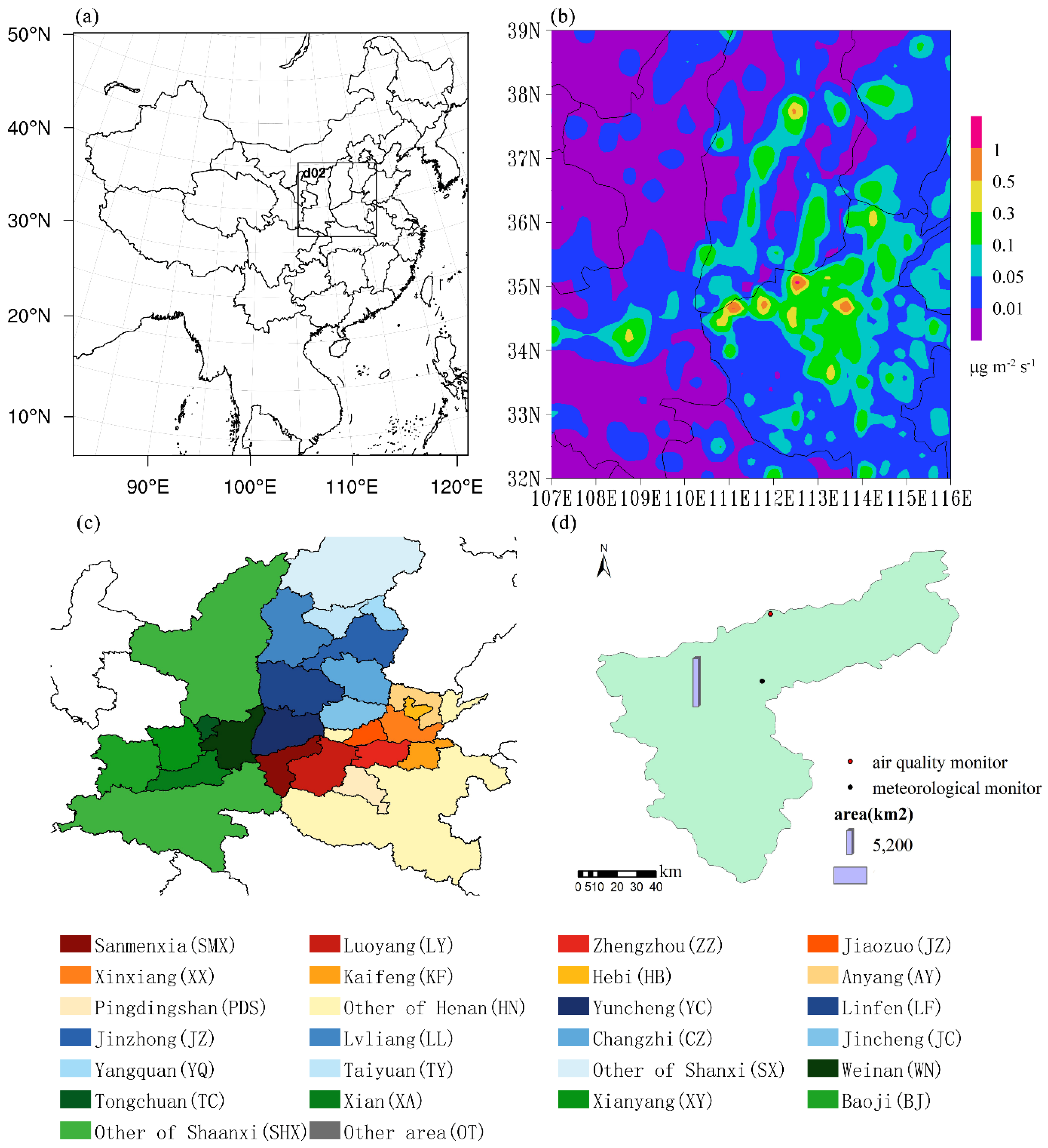


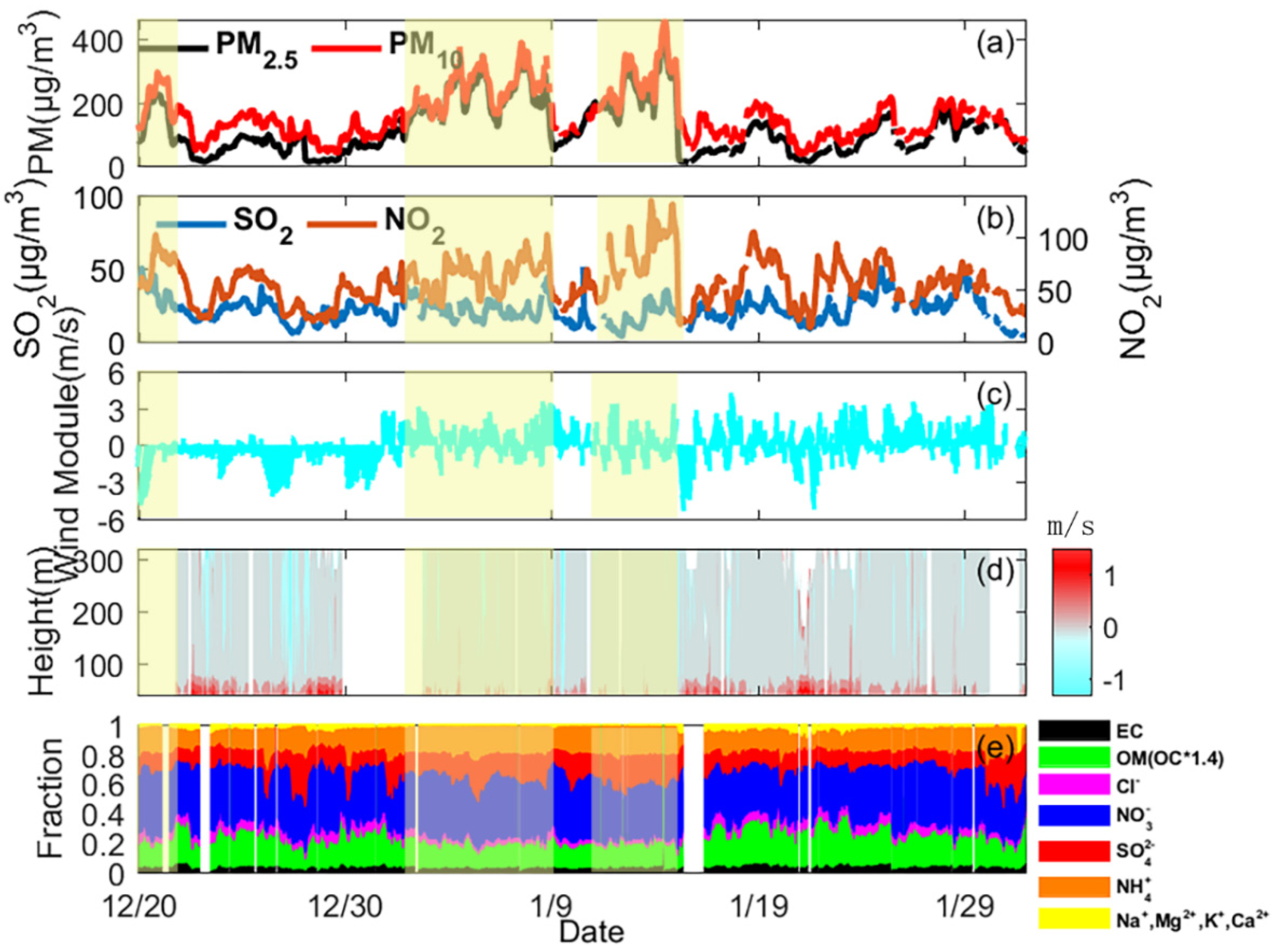
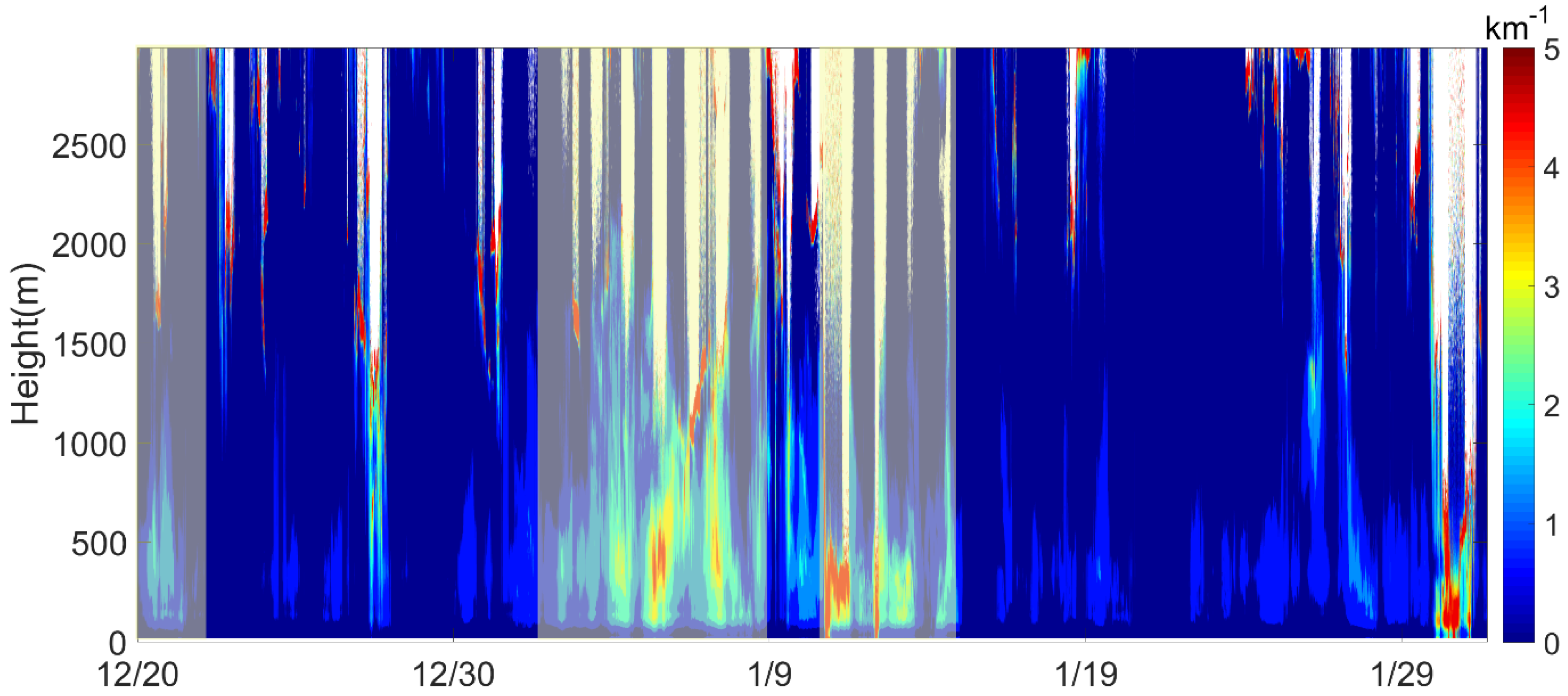


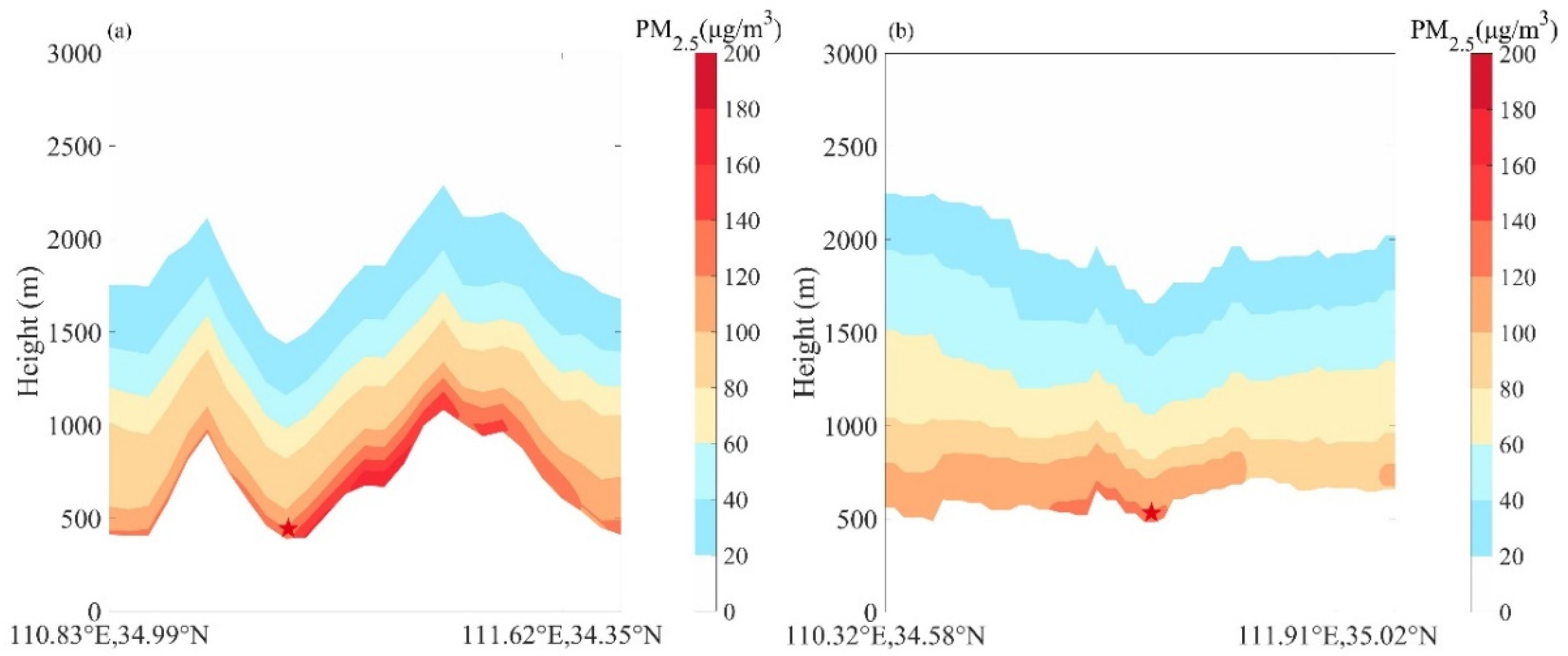
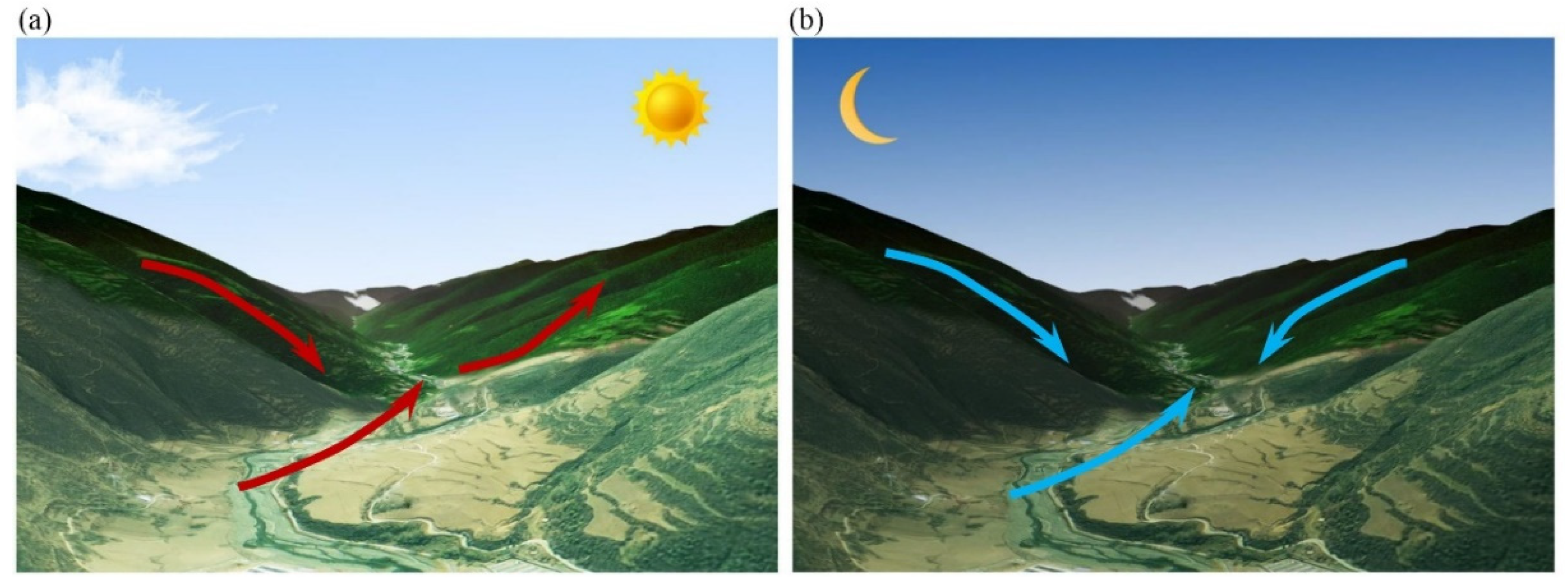
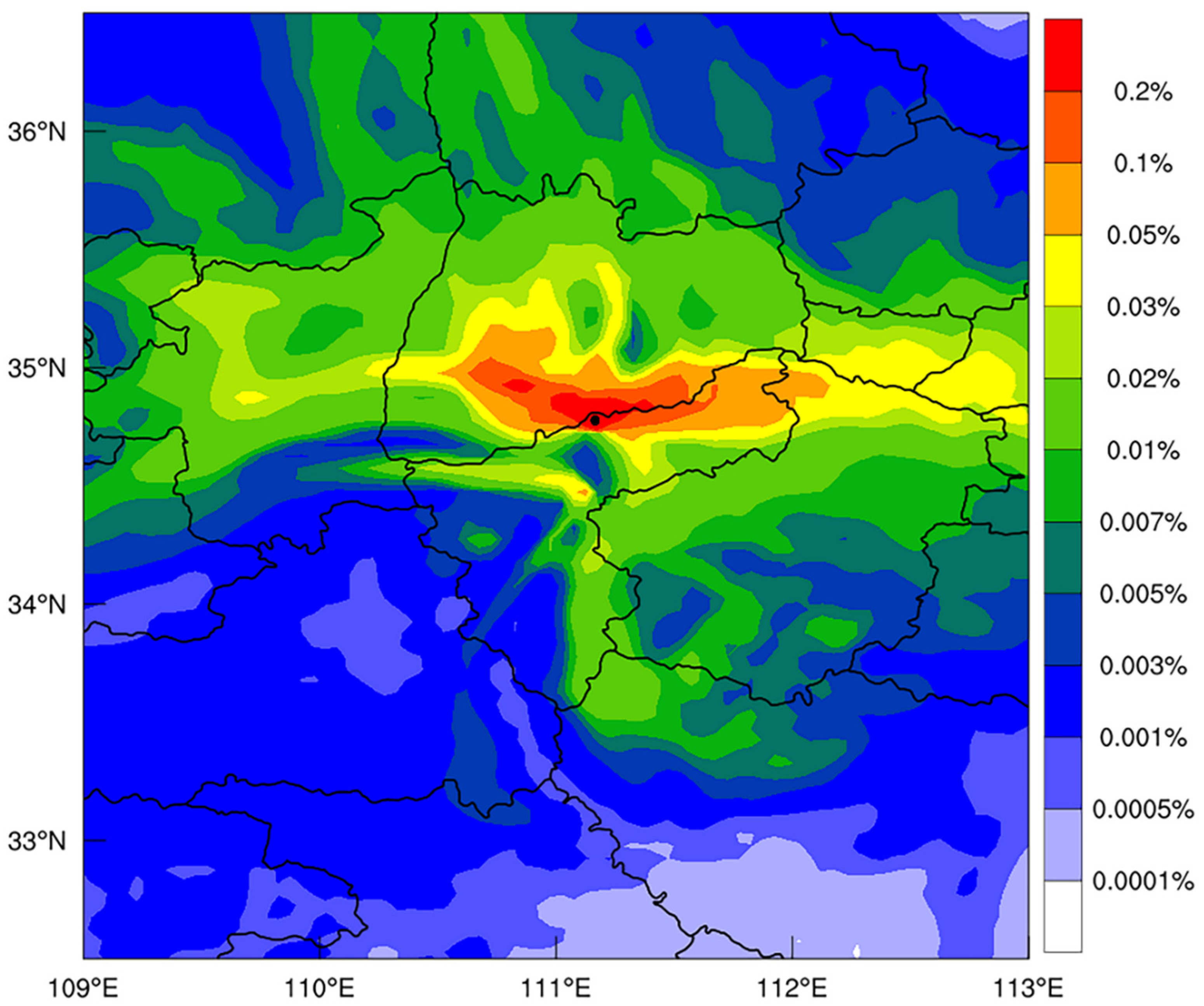

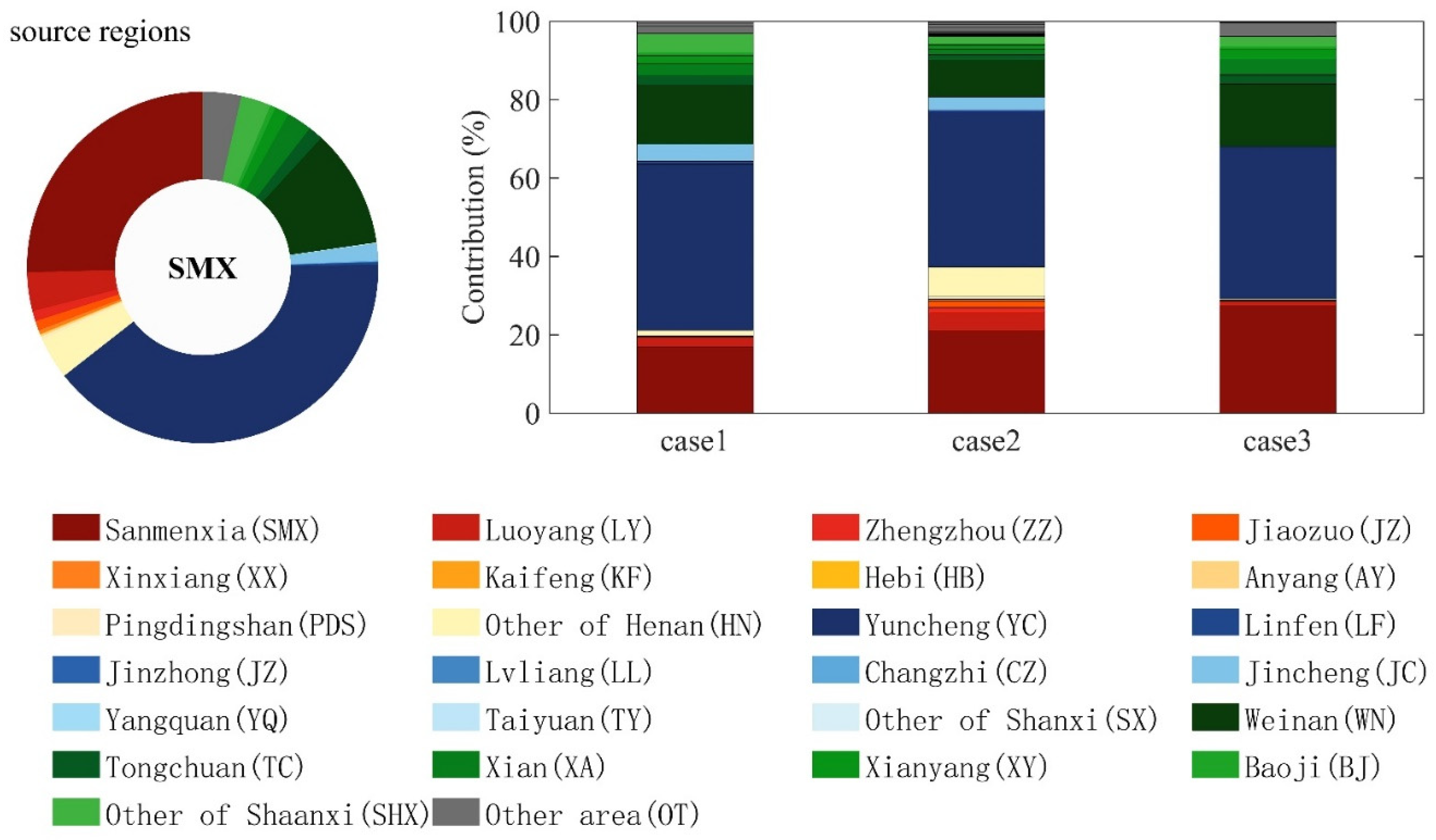
| Primary | Secondary | |||||
|---|---|---|---|---|---|---|
| Mean Results | Severe Haze Episodes | Clean Periods | Mean Results | Severe Haze Episodes | Clean Periods | |
| SMX | 37% | 44% | 33% | 11% | 10% | 12% |
| YC | 53% | 48% | 57% | 24% | 22% | 25% |
| WN | 3% | 5% | 3% | 20% | 28% | 18% |
| HN-O | 6% | 2% | 6% | 16% | 7% | 16% |
| SHX-O | 1% | 1% | 1% | 18% | 24% | 18% |
| SX-O | 0% | 0% | 0% | 4% | 2% | 4% |
| OT | 0% | 0% | 0% | 7% | 7% | 7% |
Publisher’s Note: MDPI stays neutral with regard to jurisdictional claims in published maps and institutional affiliations. |
© 2022 by the authors. Licensee MDPI, Basel, Switzerland. This article is an open access article distributed under the terms and conditions of the Creative Commons Attribution (CC BY) license (https://creativecommons.org/licenses/by/4.0/).
Share and Cite
Li, Y.; Wang, X.; Li, J.; Zhu, L.; Chen, Y. Numerical Simulation of Topography Impact on Transport and Source Apportionment on PM2.5 in a Polluted City in Fenwei Plain. Atmosphere 2022, 13, 233. https://doi.org/10.3390/atmos13020233
Li Y, Wang X, Li J, Zhu L, Chen Y. Numerical Simulation of Topography Impact on Transport and Source Apportionment on PM2.5 in a Polluted City in Fenwei Plain. Atmosphere. 2022; 13(2):233. https://doi.org/10.3390/atmos13020233
Chicago/Turabian StyleLi, Yanyu, Xuan Wang, Jie Li, Lingyun Zhu, and Yong Chen. 2022. "Numerical Simulation of Topography Impact on Transport and Source Apportionment on PM2.5 in a Polluted City in Fenwei Plain" Atmosphere 13, no. 2: 233. https://doi.org/10.3390/atmos13020233






